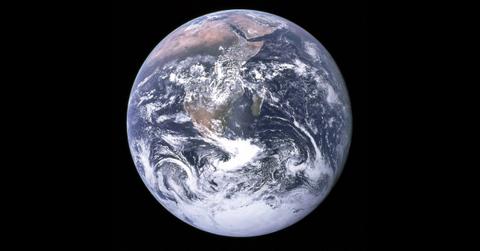Could Alien Planet Remnants Have Helped Form Earth and Our Moon After Catastrophic Crash?

The ‘overview effect’ is caused by the sight of Earth from space.
Nov. 6 2023, Published 3:02 p.m. ET
Could remnants of an ancient alien planet be below our feet?
Well, that's what some researchers who published a recent study are asserting, Knewz.com reported.
A new study published in the journal Nature on Nov. 1, suggests that two continent-sized blobs of material that were discovered in the 1980s are chunks of an alien planet that crashed into the Earth billions of years ago.
The study, conducted by researchers at the California Institute of Technology, notes that the remnants, which are believed to be pieces of protoplanet Theia, are approximately the same size as Mars.
The researchers used new computer modeling to support the assertion, which Robin Canup, a planetary scientist at the Southwest Research Institute in Boulder, Colorado, says is not a new theory.
“But this paper is the first in my mind to really take that notion seriously,” she said.
The collision of Earth and the blobs, which are believed to be beneath the African continent and Pacific Ocean, also has long been credited with the formation of the Earth's moon.
Scientists say such a collision would explain the lack of many volatile compounds on the moon that would have been vaporized in the crash.
Through a computer simulation, researchers learned how the impact of chunks of Theia crashing into Earth would play out. According to the simulation, material from Theia initially sank to the bottom portion of Earth's mantle and that more of it formed over time to formulate the blobs.
Researchers theorize, through an expanded model, that the energy from the collision would have partially melted the Earth's mantle, forming two layers: a molten top and a mostly solid bottom.
Researchers say some of the Theia material would mold with Earth material while other chunks would sink through the molten portion of the mantle and lodge themselves in the bottom layer to form the blobs.
The theory also contends that other Theia material was launched into orbit and formed the Earth's moon.
Never miss a story — sign up for the Front Page Detectives newsletter. Be on the scene the moment news breaks.
Qian Yuan, O.K. Earl Postdoctoral Scholar Research Associate and leader of the research, said he came up with the idea to conduct the study after attending a seminar on planet formation led by Mikhail Zolotov, a professor at Arizona State University, in 2019.
"Right after Mikhail had said that no one knows where the impactor is now, I had a 'eureka moment' and realized that the iron-rich impactor could have transformed into mantle blobs," Yuan said in a news release, according to Newsweek.
Become a Front Page Detective
Sign up to receive breaking
Front Page Detectives
news and exclusive investigations.
